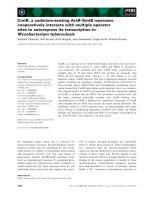Make a Difference at Your School! CDC Resources Can Help You Implement Strategies to Prevent Obesity Among Children and Adolescents pptx
Bạn đang xem bản rút gọn của tài liệu. Xem và tải ngay bản đầy đủ của tài liệu tại đây (1.65 MB, 8 trang )
Make a Difference
at Your School!
CDC Resources Can Help You Implement Strategies
to Prevent Obesity Among Children and Adolescents
U.S. Department of Health and Human Services
Centers for Disease Control and Prevention
The Impact of Obesity
Obesity is increasing rapidly in the United States, affecting children, adolescents, and adults of all races, ethnicities,
and income levels.
Since 1980, the percentage of obese children aged 6 to 11 has doubled, and the percentage of obese
adolescents aged 12 to 19 has tripled. Childhood obesity has both immediate and long-term serious health impacts.
• In some communities, almost half of pediatric diabetes cases are type 2 diabetes, which was once
believed to affect only adults.
• In one large study, 61% of obese 5- to 10-year-olds already had risk factors for heart disease, and
26% had two or more risk factors for the disease.
• Obese children have a greater risk of social
and psychological problems, such as
discrimination and poor self-
esteem.
• Obese children have a 70% chance of being
overweight or obese as adults—facing higher risks for
many diseases, such as heart disease, diabetes, stroke, and
several types of cancers.
The costs of treating obesity-related diseases are staggering and rising rapidly.
In 2004, direct and indirect health costs associated with obesity were $98 billion.
Good eating habits and regular physical activity are critical for maintaining a
healthy weight. Unfortunately, less than 25% of adolescents eat enough fruits
and vegetables each day
. Sixty-four percent of high school students don't meet
currently recommended levels of physical activity
.
The Role of Schools in Preventing Childhood Obesity
Reversing the obesity epidemic requires a long-term, well-coordinated approach to
reach young people where they live, learn, and play, and schools have an important
role. Working with other public, voluntary, and private sector organizations, schools
can play a critical role in reshaping social and physical environments and providing
information, tools, and practical strategies to help students adopt healthy lifestyles.
• More than 95% of young people are enrolled in schools.
• Students have the opportunity to eat a large portion of their daily food intake
and to be physically active at school.
• Schools are an ideal setting for teaching young people how to adopt and
maintain a healthy, active lifestyle.
• Research shows that well-designed, well-implemented school programs
can effectively promote physical activity and healthy eating
.
• Emerging research documents the connections between physical activity,
good nutrition, physical education and nutrition programs, and
academic performance.
Ten Strategies for Schools to Promote Physical Activity and Healthy Eating
The Centers for Disease Control and Prevention (CDC) reviews scientific evidence to determine which school-based
policies and practices are most likely to improve key health behaviors among young people, including physical activity
and healthy eating. Based on these reviews, CDC has identified 10 strategies to help schools prevent obesity by
promoting physical activity and healthy eating. CDC and its partners have developed user-friendly tools that help schools
effectively implement each of the strategies.
Building the Foundation (Strategies 1–4)
Schools can build a strong foundation that will enable
them to effectively promote physical activity and healthy
eating as well as other health-enhancing behaviors.
The first four strategies help schools develop a tailored
approach that meets their specific, local needs and
interests; earn the support and commitment of the
school community; use the insights gained from
scientific research; and emphasize teamwork and
collaboration to maximize effectiveness and efficiency.
Strategy 1: Address physical activity and
nutrition through a Coordinated School
Health Program (CSHP).
CSHPs provide a systematic approach to promoting
student health and learning. The model promoted by
CDC consists of eight components that can strongly
influence student health and learning including health
education, physical eduation, and school meals, which
are present in most schools. CSHPs focus on improving
the quality of each of these components and expanding
collaboration among the people responsible for them
in the school and in the community. Active coordination
is needed to engage school staff, implement district/
school priority actions; assess programs and policies;
create a plan based on data, sound science, and
analysis of gaps and redundancies in school health
programming; establish goals; and evaluate efforts.
A well-coordinated school health program results in
an organized set of courses, services, policies, and
interventions that meet the health and safety needs of all
students from kindergarten through grade 12.
Health Is Academic: A Guide to Coordinated
School Health Programs
Developed by the Education Development Center with
support from CDC and
in collaboration with
more than 70 national
organizations, this
book describes how
the eight components
of a CSHP can work
together to support
students and help
them acquire the
knowledge and skills
they need to become
healthy, productive
adults. It includes
CSHP implementation action steps for schools, districts,
state agencies, national organizations, colleges,
and universities. Search on the American School
Association’s website.
www.ashaweb.org/store/products/
Strategy 2: Maintain an active school health
council and designate a school health
coordinator.
Establishing a school health council (SHC) is an
effective way to achieve an enduring focus on
promoting physical activity and healthy eating. SHCs can
help schools meet the federal law passed in 2004 that
requires all school districts that participate in
federally funded school meal programs to establish
a local school wellness policy through a process that
involves parents, students, school representatives, and
the public.
Comprising representatives from the home, school, and
community, SHCs establish goals for the school health
program and facilitate health programming in the school
and between the school and community. Guided by
the SHC’s vision, a school health coordinator manages
and coordinates all school health policies, programs,
activities, and resources. SHCs have helped create
lasting changes in school environments, such as the
adoption of nutrition standards, establishment of student
and staff walking programs, the provision of adequate
class time for physical education and health education,
and the opening of school facilities for after-school
physical activity programs.
Promoting Healthy Youth, Schools, and
Communities: A Guide to Community-School
Health Councils
This how-to manual offers a practical, five-step
approach to planning, developing, maintaining, and
evaluating SHCs. It was developed by a number
of CDC partners—originally produced by the Iowa
Department of Public Health, it was adapted for use
by the American Cancer Society in collaboration with
the American School Health Association, American
Academy of Pediatrics, and National Center for
Health Education.
www.cancer.org/schoolhealthcouncil
Effective School Health Advisory Councils:
Moving from Policy to Action
This guide was developed by CDC’s partners at
the North Carolina Department of Public Instruction to
help school district personnel and others develop new
SHCs or strengthen existing ones that can effectively
support school health policies and programs.
www.nchealthyschools.org/docs/resources/tools/
shacmanual.pdf
Strategy 3: Assess the school’s health policies
and programs and develop a plan
for improvement.
Self-assessment and planning provide structure to a
coordinated school health program in the way that a
map provides guidance to a driver. The self-
assessment describes where the program is now, and
the plan provides the destination and directions to make
improvements. A school health plan is most likely to
be effective when it is based on a systematic analysis
of existing policies and practices, guided by insights
from research, and developed by an SHC that includes
teachers, parents, school administrators, students, and
the community.
CDC’s School Health Index (SHI):
A Self-Assessment Planning Guide
This easy-to-use self-assessment and planning tool
enables SHCs and others to analyze the strengths
and weaknesses of
their school health
policies, curricula,
and services. The SHI
features eight self-
assessment modules,
each corresponding
to one of the CSHP
components. Based on
their self-assessment,
school health teams
identify goals and
create an action plan
tailored for their school.
Many schools are incorporating these plans into their
overall educational improvement plans. The SHI can be
completed using a paper or online version.
www.cdc.gov/HealthyYouth/SHI
Strategy 4: Strengthen the school’s nutrition
and physical activity policies.
School policies can dictate how often students attend
physical education, which items go into school vending
machines, which topics and skills are taught in health
education, which foods are served in the cafeteria, and
much more. School policies directly affect students’
opportunities for physical activity and healthy eating and
can support the implementation of all other
strategies listed in this document.
Fit, Healthy, and Ready to Learn:
A School Health Policy Guide (FHRTL)
Developed by the
National Association
of State Boards of
Education (NASBE)
with CDC support,
this practical guide
helps schools and
local school districts
establish strong policies
on physical activity,
nutrition, and other health issues in the context of a
CSHP. FHRTL features sample policies that reflect best
practice and can be adapted to fit local circumstances;
it also includes explanations of the points addressed
in the sample policies and excerpts of actual state and
local policies.
ww.nasbe.org/HealthySchools/fithealthy.html
NASBE also maintains a database of state school
health policies that can serve as models for new policy
development.
www.nasbe.org/HealthySchools/States/
State_Policy.asp
Wellness Policy Guidance
Developed in collaboration with CDC and the U.S.
Department of Education, this U.S. Department of
Agriculture (USDA) website provides information on how
to create, implement, and evaluate wellness policies
that meet the requirements of federal law.
www.fns.usda.gov/tn/Healthy/wellnesspolicy.html
Wellness Policy Development Tool
Developed by Action for Healthy Kids in partnership
with CDC and USDA, this searchable online database
consists of existing or model nutrition and physical
activity policies from states and districts around the
country. Schools can easily use language from policies
in the database to build local wellness policies.
www.actionforhealthykids.org/resources_wp.php
Taking Action (Strategies 5–10)
With a strong foundation in place, schools can work
on improving programs and activities that serve both
students and staff members. Strategies 5 through 10
are derived from CDC’s research-based guidelines that
identify school practices that promote lifelong physical
activity and healthy eating.
Strategy 5: Implement a high-quality health
promotion program for school staff.
Staff wellness programs provide opportunities for school
staff members to participate in health assessments,
nutrition classes, physical activity programs, and other
health promotion activities. These opportunities can
contribute to improvements in physical and mental
health outcomes; increases in morale, productivity, and
positive role modeling; and decreases in absenteeism
and health insurance costs.
School Employee Wellness: A Guide for
Protecting the Assets of Our Nation's Schools
Developed by the
Directors of Health
Promotion and
Education (DHPE) with
CDC support, School
Employee Wellness: A
Guide for Protecting the
Assets of Our Nation's
Schools, is designed to
help schools, districts,
and states develop
comprehensive school
employee wellness
programs. This resource provides guidance for obtaining
program support, developing a school employee
wellness team, using existing data to optimize a new
or existing program, and implementing policies and
practices to support employee wellness.
www.schoolempwell.org
Strategy 6: Implement a high-quality course of
study in health education.
Health education provides formal opportunities for
students to acquire knowledge and learn essential life
skills that can foster healthy behaviors, such as physical
activity and healthy eating. Taught by qualified teachers,
quality health education includes instruction on essential
topics and skills that protect and promote physical,
social, and emotional health and safety and provides
students with ample opportunities to practice health-
enhancing behaviors. State-of-the-art health education
features a sequential curriculum consistent with state
or national standards, adequate instructional time, and
assessment to improve students’ knowledge and skills.
Health Education Curriculum Analyses Tool
(HECAT)
This tool enables
schools or school
districts to choose
or develop health
education curricula
that meet local needs
and interets and are
likely to be effective
in improving students'
knowledge, skills,
and health behaviors.
The HECAT is
based on rigorous
reviews of research evidence and is closely aligned
with the National Health Education Standards. It allows
educators to evaluate curricula based on the extent
to which they contain elements of effective health
education: those characteristics that are common to
effective programs and most likely account for their
positive outcomes. This edition of the HECAT covers
physical activity, nutrition, and tobacco, along with
alcohol and other drugs. Available in early 2008.
www.cdc.gov/HealthyYouth
School Health Education Resources
This searchable website provides user-friendly access to
the myriad school health education offerings available
from CDC, including curricula and lessons, fact
sheets, and other instructional materials for use by
teachers and students. The curricular resources
are aligned with the characteristics of an effective
health education curriculum and the updated
National Health Education Standards, which can
be accessed from the website.
www.cdc.gov/HealthyYouth/SHER
Strategy 7: Implement a high-quality course
of study in physical education.
Physical education is the cornerstone of a
comprehensive approach to promoting physical activity
through schools. All students, from pre-kindergarten
through grade 12, should participate in quality physical
education classes every school day. Physical education
not only provides opportunities for students to be active
during the school day, but also helps them develop
the knowledge, attitudes, skills, behaviors, and
confidence needed to be physically active for life.
CDC’s Physical Education Curriculum Analysis
Tool (PECAT)
This tool enables educators to evaluate physical
education curricula based on the extent to which the
curricula align with national standards, guidelines, and
best practices for quality physical education programs.
The PECAT can be
used to identify where
revisions might be
needed in a locally
developed curriculum
or to compare strengths
and weaknesses of
published physical
education curricula
being considered for
adoption. For those
schools without a
physical education
curriculum, the PECAT
provides a vision of what should be included in a high-
quality written physical education curriculum.
www.cdc.gov/HealthyYouth/PECAT
Strategy 8: Increase opportunities for
students to engage in physical
activity.
The school setting offers
multiple opportunities for all
students, not just those who
are athletically inclined,
to enjoy physical activity
outside of physical
education classes:
walking to and from
school; enjoying recess;
physical activity clubs, and
intramural sports programs; and
having classroom lessons that
incorporate physical activities.
These opportunities help
students learn how to weave
physical activity into their
daily routines.
KidsWalk-to-School
This manual provides guidance for schools and
communities on how to create an environment that
supports safe walking and bicycling to school.
It includes educational materials to help promote
walking to school and suggests strategies for
communities to overcome barriers to walking to school.
www.cdc.gov/nccdphp/dnpa/kidswalk
Strategy 9: Implement a quality school
meals program.
Each school day, millions of students eat one or two
meals provided as part of the federally funded school
meals program. These meals have a substantial impact
on the nutritional quality of students’ overall dietary
intake and provide a valuable opportunity for students
to learn about good nutrition. CDC supports USDA
efforts to ensure that meals served through the National
School Lunch Program and School Breakfast Program
are safe, nutritious, and balanced.
Changing the Scene:
Improving the School Nutrition Environment
This USDA Team Nutrition tool kit, developed with
technical assistance from CDC, provides guidance
and ready-to-use resources designed to help schools
implement a comprehensive and consistent approach
to promoting healthy eating among students. The kit
addresses the entire school nutrition environment and
includes guidance on serving and marketing quality
school meals in a pleasant eating environment. Many
other school meal guidance tools are available from the
Team Nutrition website.
www.fns.usda.gov/TN/resources/changing.html
Strategy 10: Ensure that students have
appealing, healthy choices in foods and
beverages offered outside of the school
meals program.
Most schools offer foods and beverages to students
through a variety of channels outside of the federally
regulated school meals program: vending machines,
school stores, concession stands, after-school programs,
fundraising campaigns, and class parties. These
offerings have dramatically increased student access to
high-fat or high-sodium snacks and non-nutritious high-
calorie beverages. Although federal regulations on these
foods and beverages are limited, many states, school
districts, and schools are establishing strong policies and
innovative marketing practices to promote the sale of
healthier foods and beverages.
Making It Happen:
School Nutrition Success Stories
This resource, developed by CDC and the USDA’s
Team Nutrition with
support from the
U.S. Department of
Education, describes six
strategies that schools
have implemented to
improve the nutritional
quality of foods and
beverages offered on
campus. It also tells the
stories of 32 schools
and school districts
across the country that
have successfully implemented these strategies.
www.cdc.gov/HealthyYouth/nutrition/Making-It-
Happen/download.htm
Nutrition Standards for Food in Schools: Leading
the Way Toward
Healthier Youth
This report, from the
Institute of Medicine,
makes recommendations
about appropriate
nutritional standards
for the availability,
sale, content, and
consumption of foods
and beverages at
school, with particular
emphasis on those sold
outside of school meals.
www.iom.edu/CMS/3788/30181/42502.aspx
For more information on the role of schools
in preventing childhood obesity, please visit CDC’s website:
www.cdc.gov/HealthyYouth/KeyStrategies
January 2008 (CS116926)









